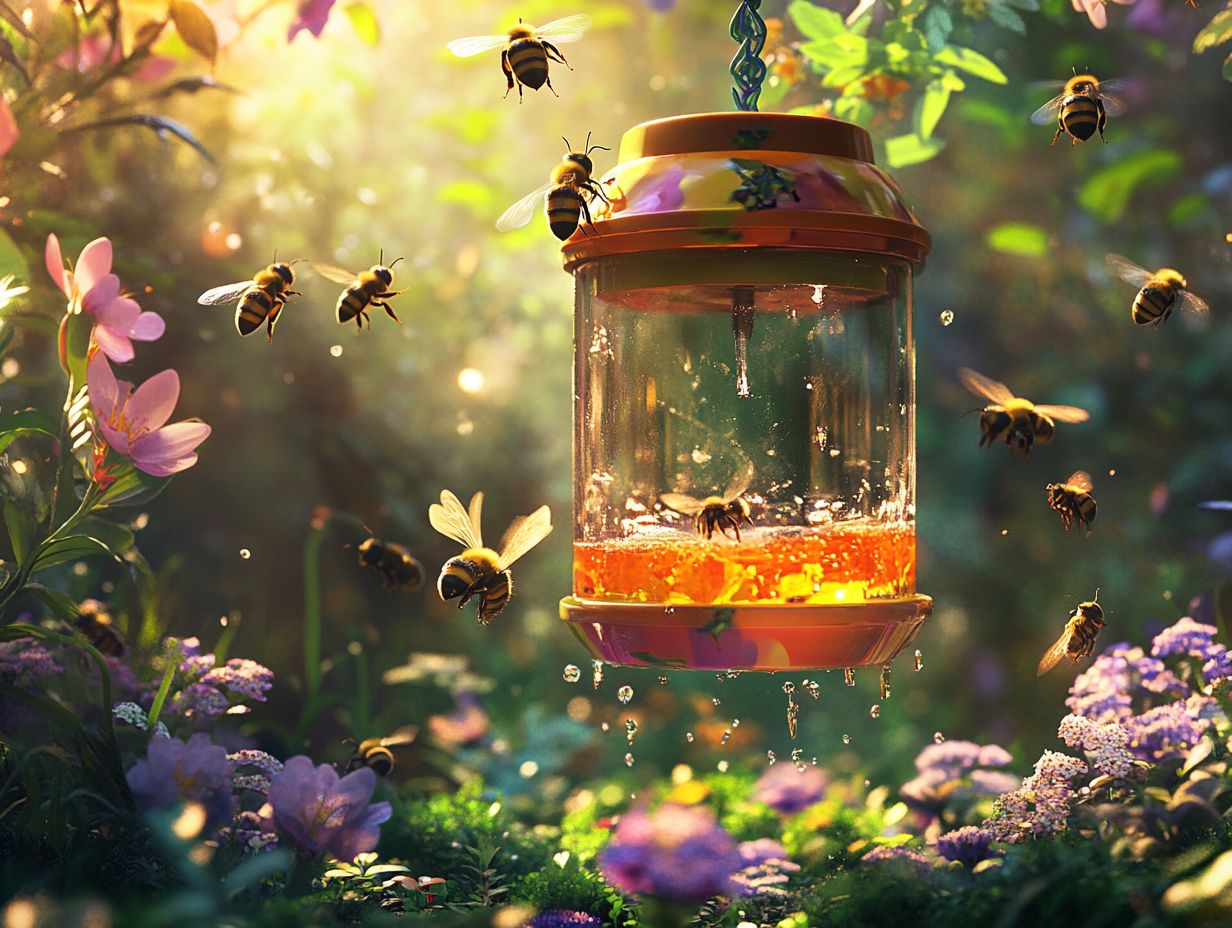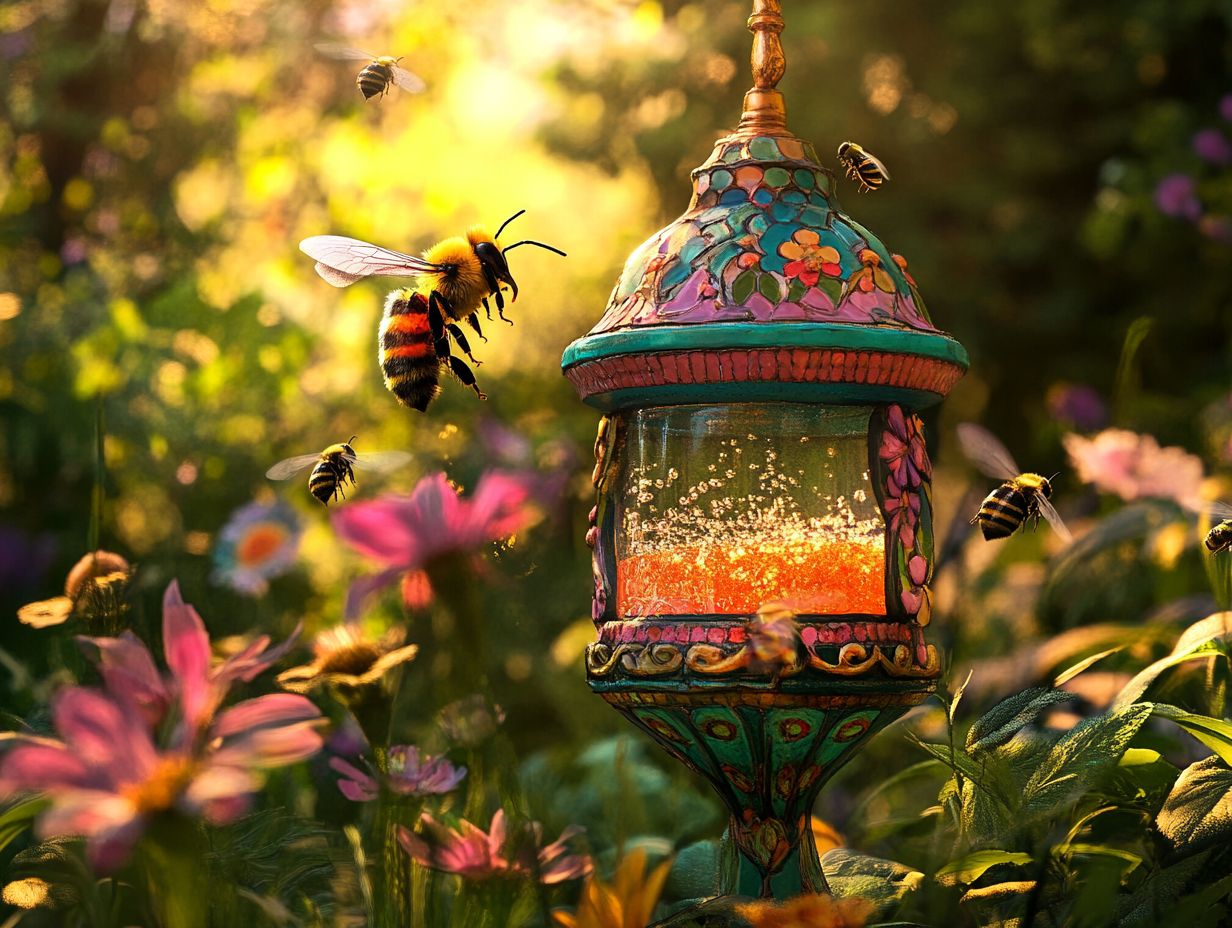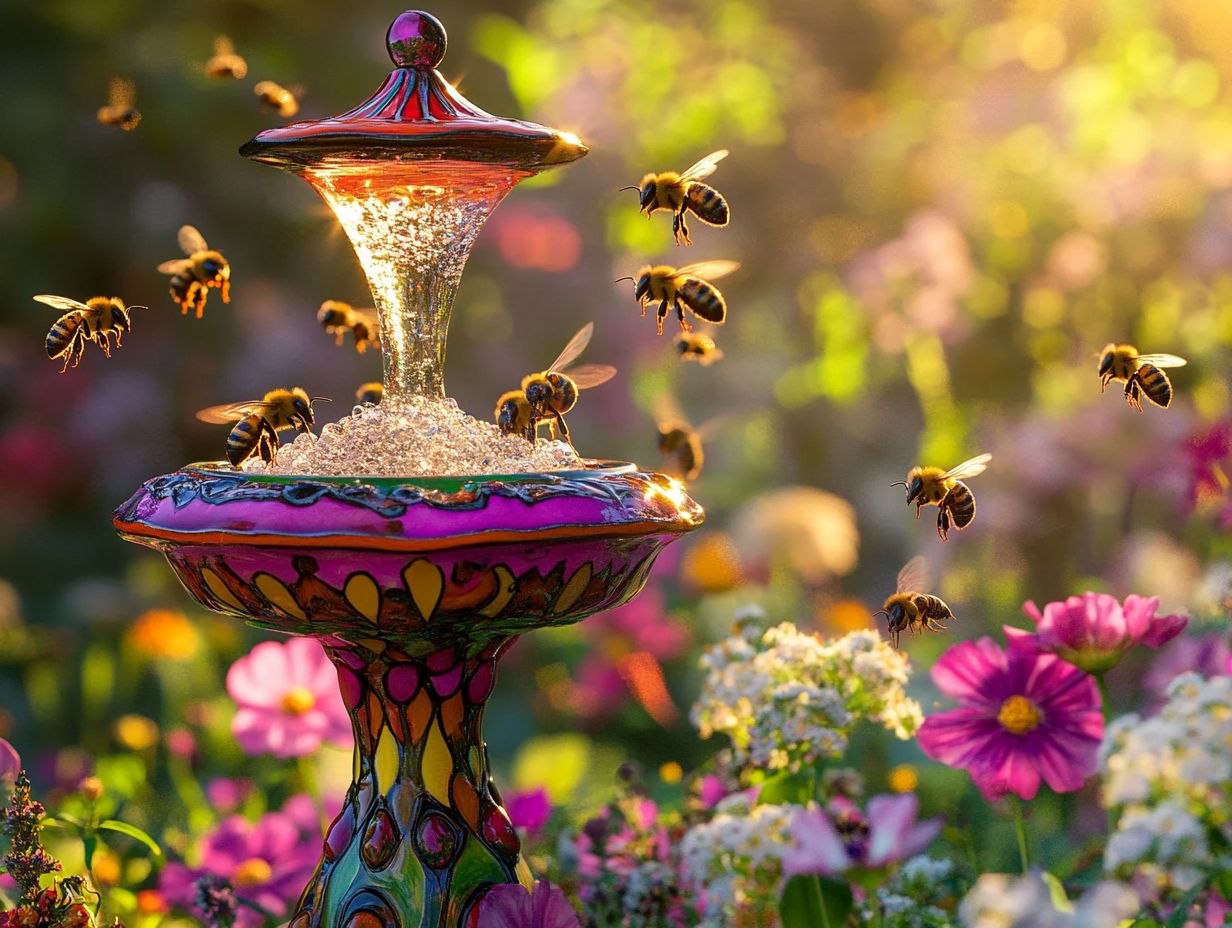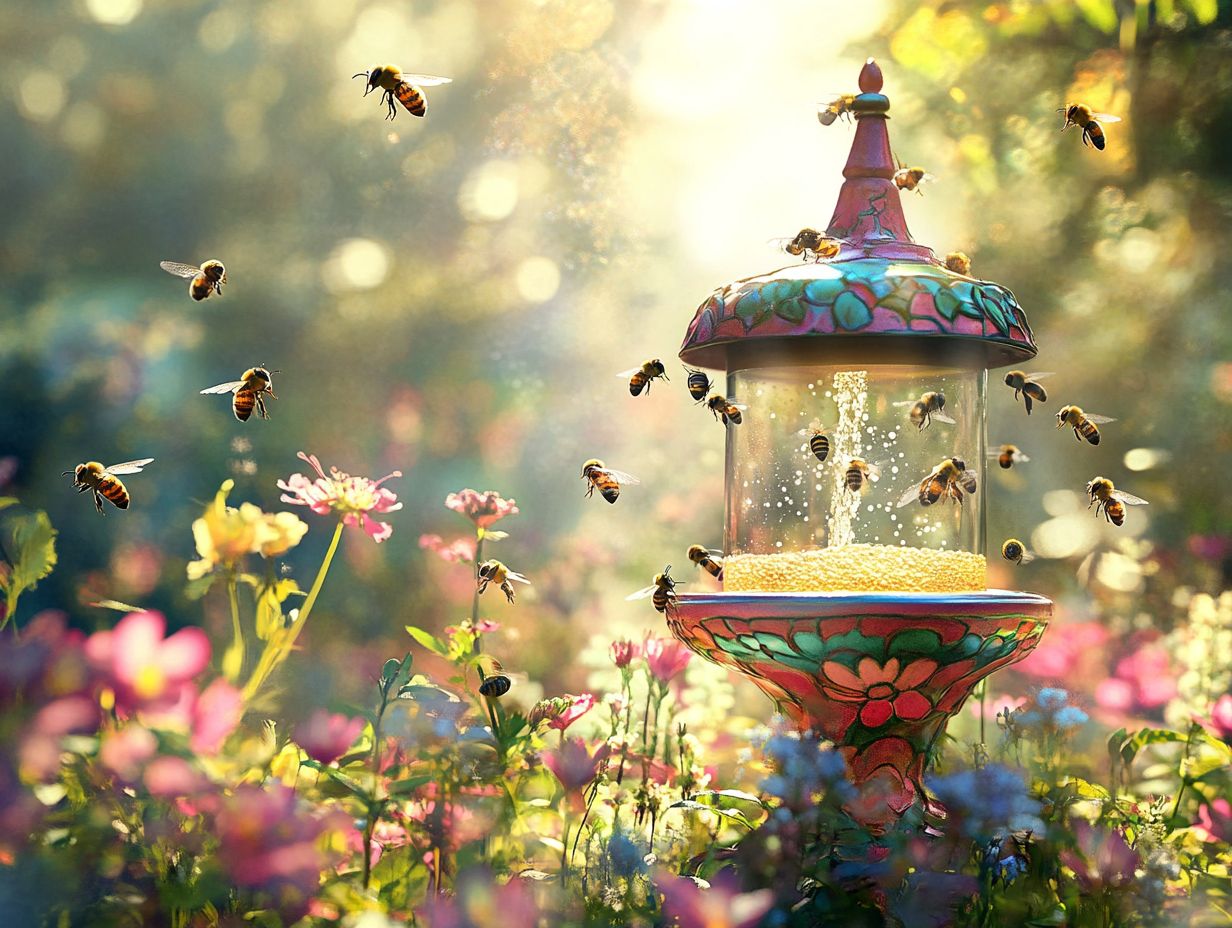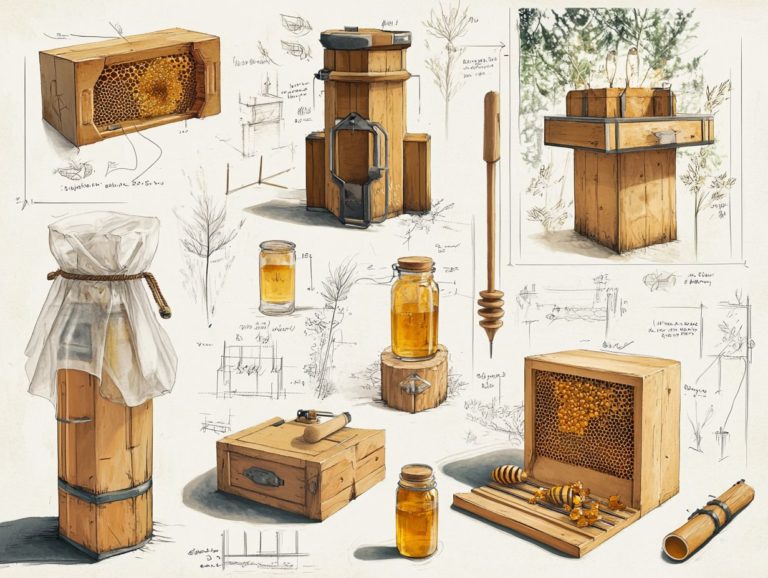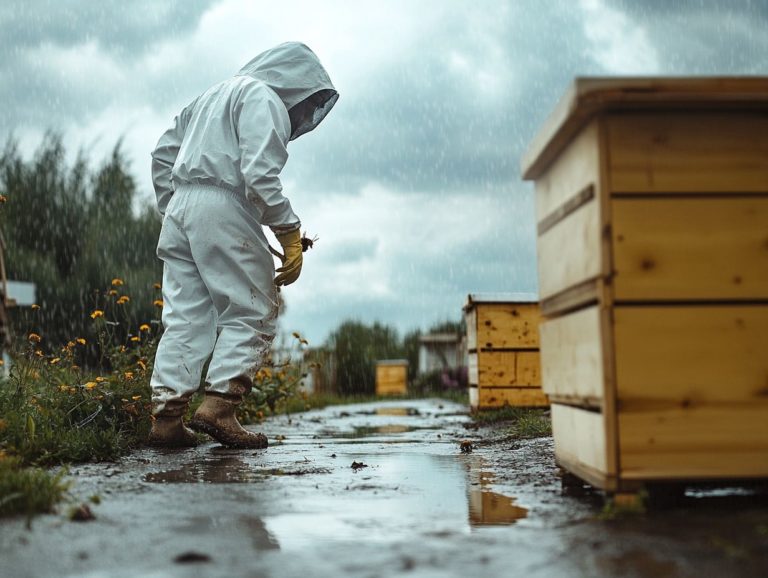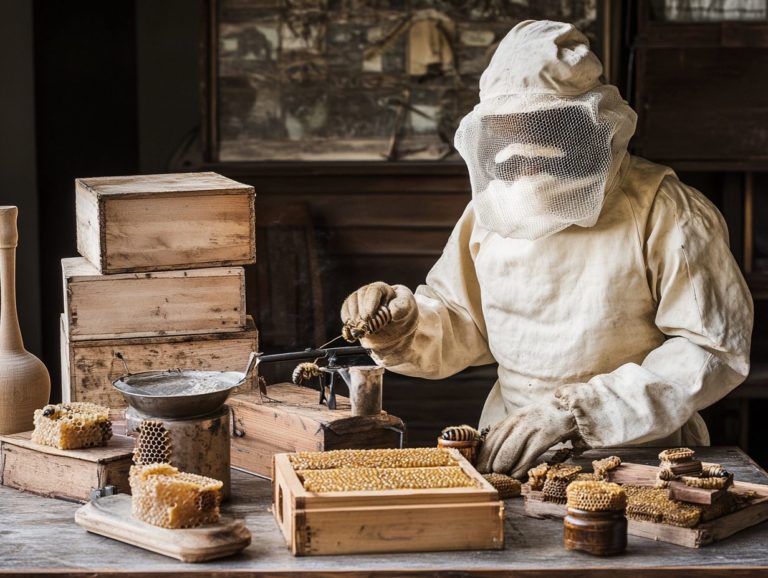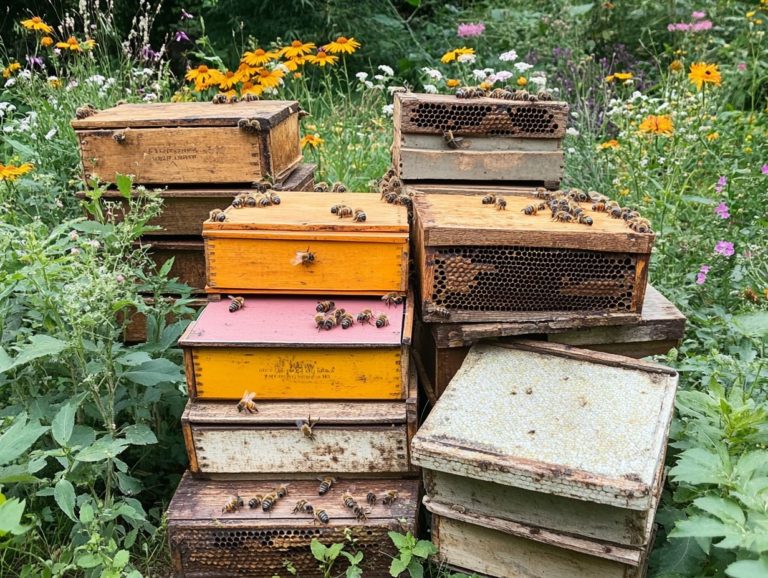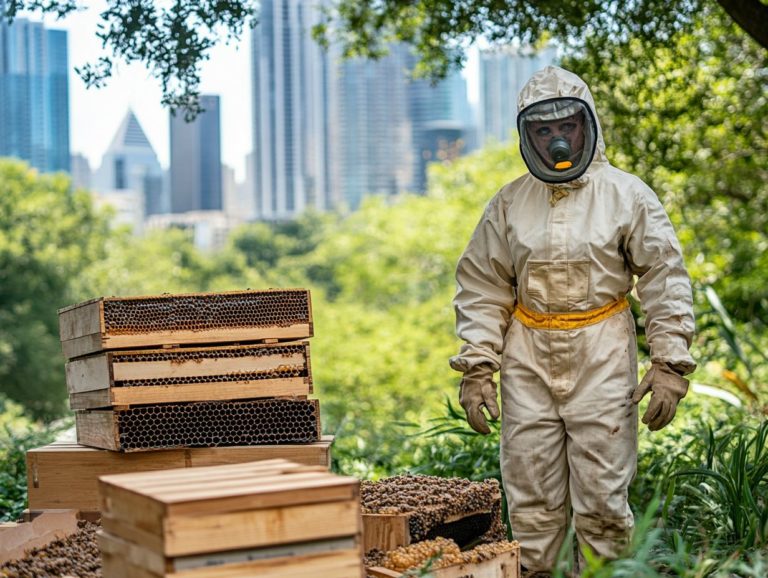What You Should Know About Bee Feeders
Bee feeders are essential for the health and productivity of your hive, especially during tough times.
Whether you’re a seasoned beekeeper or just starting this rewarding journey, understanding the different types of feeders, their benefits, and proper usage can profoundly impact your bees’ well-being.
This article covers everything you need to know about bee feeders, from their necessity and advantages to selecting the ideal type for your hive and avoiding common pitfalls.
Dive in to ensure your bees thrive!
Contents
Key Takeaways:
- Bee feeders are devices used to provide supplemental food for bees.
- Bees need feeders to ensure they have enough food to survive and thrive.
- There are different types of bee feeders available, such as top, entrance, division board, frame, and in-hive feeders.
What Are Bee Feeders?
Bee feeders are essential tools crafted to nourish honeybee colonies, especially during tough times like spring when natural food sources can dwindle.
These feeders act as feeding stations, enabling you to ensure your hives have access to essential resources such as sugar water, liquid honey, and pollen—ingredients critical for the survival and well-being of your bees.
By thoughtfully placing feeders around your bee yard, you can optimize your feeding strategy, minimize competition among colonies, and address potential issues like robbing and the spread of diseases, including varroa mites, harmful parasites that can weaken bee colonies.
Why Do Bees Need Feeders?
Bees rely on feeders for several important reasons, especially during times when food is scarce, such as winter or early spring when honey flow diminishes and natural resources become limited.
By offering supplemental feeding—whether it’s sugar syrup or pollen—you can ensure that your colonies have the essential provisions needed to weather harsh conditions and combat diseases and pests like varroa mites.
Feeders not only bolster bee health but also elevate productivity across your entire bee yard, enabling your bees to flourish with access to vital nutrients.
What Are the Benefits of Using Bee Feeders?
Utilizing bee feeders offers many advantages for both you and your bees, especially when it comes to maximizing honey production and enhancing overall bee health.
By implementing effective feeding techniques, you can ensure that your colonies receive the necessary nutrition during critical periods, which reduces the risk of disease and boosts hive vitality.
Providing sugar syrup or other resources through strategically placed feeders allows you to enhance honey production, support colony growth, and offer a reliable food source when natural foraging becomes a challenge.
These feeding strategies dramatically reduce competition among your colonies for food, giving your bees the best chance to thrive!
With an increase in honey yield, you can look forward to a more prosperous season while maintaining a stable and thriving bee population. Healthier colonies not only produce more honey but are also better equipped to withstand environmental stressors and pathogens.
This holistic approach promotes sustainable beekeeping practices, ensuring that both you and your bees thrive together in harmony, ultimately benefiting the ecosystem.
Types of Bee Feeders
You’ll find a variety of bee feeders available to you, each crafted with unique features to meet the diverse needs of honey bees.
Familiarizing yourself with the different options—like top feeders that rest on the hive, entrance feeders that offer easy access, and frame feeders designed to fit snugly within the hive—can greatly enhance your colony’s ability to forage for food effectively.
Opting for plastic buckets as outdoor feeders not only presents a convenient solution but also helps reduce the risk of robbing between hives.
1. Top Feeders
Top feeders are an excellent addition to your hive, offering honey bees easy access to sugar syrup without needing to venture outside. This makes them a favorite among beekeepers.
They’re especially valuable during early spring when natural nectar is scarce. Top feeders help your colonies quickly build their food reserves and strength.
By keeping bees protected from external elements, top feeders also play an important part in disease prevention and moisture control—both critical for maintaining hive health.
These feeders often feature a deep reservoir and access holes, allowing bees to feed comfortably, which reduces stress and increases consumption rates. This method of feeding supports your colony’s growth and productivity, enabling hives to thrive even in tough conditions.
With top feeders, you can effortlessly monitor syrup levels and adjust feeding as needed without disturbing the colony, leading to more effective hive management.
The enhanced nutrition provided through top feeders lays a solid foundation for successful foraging when blooming seasons arrive, ultimately maximizing overall bee health and honey production.
2. Boardman Entrance Feeders
Boardman entrance feeders are exceptional tools crafted to enable honey bees to feed directly at the hive’s entrance, granting them effortless access to vital resources like sugar water. This type of feeder allows you to monitor feeding behaviors while minimizing the risk of robbing from neighboring colonies.
By positioning the feeder near the hive’s entrance, you can manage the food supply effectively without disrupting the hive’s internal dynamics. However, it’s important to consider potential drawbacks, such as attracting unwanted pests or inviting competitors to invade.
The installation of a Boardman feeder influences how your bees forage and can also boost their overall health by alleviating the stress associated with starvation. Understanding these factors helps you maintain strong, vibrant colonies that thrive in their environment.
3. Division Board Feeders
Division board feeders offer a sophisticated solution that seamlessly integrates into the hive, granting honey bees direct access to liquid food sources like sugar syrup. These feeders are particularly beneficial during the honey flow, ensuring that your bees can gather and store food efficiently without disruptions posed by external conditions.
Optimizing feeding within the hive creates a more stable environment conducive to colony growth and health. Their design minimizes disruption to the hive’s interior, significantly reducing competition among foragers and enhancing the efficiency of food intake.
To make the most of these feeders, consider these best practices:
- Regularly monitor syrup levels.
- Ensure proper placement within the hive to encourage usage.
Choosing high-quality materials can bolster durability and long-term functionality, crucial for sustaining robust bee populations.
4. Frame Feeders
Frame feeders are a sophisticated type of in-hive feeder designed to seamlessly replace specific frames within your beehive, offering a smooth feeding experience for your honey bees. This integrated approach encourages your bees to forage more effectively and meet their nutritional needs with ease.
Especially during times when natural forage is scarce—think late winter or early spring—these feeders become invaluable. Proper nutrition is critical for the growth and overall health of your colony, influencing everything from brood production (the process of raising young bees) to honey yield.
Regular maintenance is key; by cleaning and checking for mold or contamination, you ensure that the food remains safe and appealing for your bees. Additionally, adjusting the feeder’s position can enhance accessibility, making it easier for your bees to locate and utilize the syrup provided, ultimately boosting their foraging efficiency.
Don’t wait for natural forage to run out—act now to keep your colony thriving!
5. In-Hive Feeders
In-hive feeders are essential tools that grant honey bees direct access to supplementary food sources right within their living quarters. This type of feeder can significantly boost the health of your colony by ensuring that bees can gather essential resources like sugar syrup (a mixture of sugar and water used to feed bees) and pollen without straying far from the hive, particularly during inclement weather. By facilitating easier access to nutrition, in-hive feeders enhance colony resilience and overall hive productivity.
These feeders come in a variety of designs, from entrance feeders to frame feeders, each tailored to meet specific needs and hive configurations. By implementing best practices—such as routinely monitoring the feeder’s levels and ensuring cleanliness—you can optimize bee health. Aligning your feeding strategy with seasonal demands further amplifies effectiveness, as bees require different resources throughout the year.
Utilizing in-hive feeders not only supports the sustainability of a strong colony but also contributes to the broader ecosystem by nurturing healthier bee populations.
How to Choose the Right Bee Feeder for Your Hive
Choosing the right bee feeder is key to keeping your colonies healthy and productive. Various factors, such as the location of your hive and your personal beekeeping goals, can significantly influence your decision. Consider your specific feeding strategies, like using outdoor or in-hive feeders.
It’s important to think about your feeding strategy! Choose between outdoor feeders and in-hive options to best serve your bees. Additionally, local climate conditions, the strength of your colonies, and common diseases in your area should all be pivotal considerations in determining which type of feeder will prove most effective for you. Understanding the weather patterns can also influence your feeding approach.
What Type of Feeder is Best for My Hive Location?
Your ideal feeder depends on various environmental factors, including weather conditions, nearby resources, and the natural behaviors of the bees in your area. For instance, in regions like NE GA or Central WI, you might consider outdoor feeders during warmer months to provide easy access to sugar syrup, especially when the honey flow is abundant.
Conversely, in harsher climates, in-hive feeders could be your best bet, shielding the bees from adverse conditions. A keen understanding of local conditions, such as humidity and moisture levels, can significantly shape your feeder choice.
Humidity levels, the presence of blooming flora, and local insect populations, such as yellow jackets, are also critical factors that will determine the efficacy of your chosen feeder. In particularly humid environments, mold can become a concern for sugar syrup, necessitating specific feeder designs that minimize moisture retention, including the use of plastic buckets for storage.
Additionally, the natural feeding preferences of local bee species should guide your decision; some may favor open feeding areas, while others thrive with restricted access. These choices not only influence the bees’ immediate nutrient intake but also carry longer-term implications for their overall health and productivity.
What Type of Feeder is Best for My Beekeeping Goals?
Choosing the right type of feeder based on your specific beekeeping goals is crucial for optimizing honey production and ensuring the overall health of your colonies.
For instance, if you find yourself managing a hive in an area like North West Alabama where nectar flow is unreliable, selecting a frame feeder can offer a steady supply of sugar syrup directly in the brood nest. This encourages the queen to lay more eggs, boosting colony productivity and improving the overall hive experience. Conversely, during the drier months, a top feeder might prove advantageous, providing supplemental nutrition without disturbing the hive’s structure.
By understanding these dynamics and tailoring your feeder choices accordingly, you can significantly enhance the productivity and longevity of your beekeeping endeavors. Evaluate your goals now and choose a feeder that aligns with them to boost your productivity!
How to Set Up and Use Bee Feeders
Setting up and utilizing bee feeders correctly is crucial for ensuring that honey bees have consistent access to the nourishment they require, especially during periods of food scarcity. Whether you opt for top feeders, entrance feeders, or in-hive feeders, it’s vital to follow best practices for installation and maintenance.
This includes selecting the appropriate sugar syrup formulation or even corn syrup. Ensure frequent refills to keep the feeders operating at their best. By paying attention to these details, you enhance the health of the bees and optimize your honey yield.
What Should I Put in My Bee Feeder?
When deciding what to include in your bee feeder, it’s crucial to select the right mixture that caters to the nutritional needs of your honey bees. The primary food source you’ll want to focus on is sugar syrup. For the best outcomes, consider enriching that sugar syrup with pollen or a touch of liquid honey to create a more balanced diet.
Using safe ingredients such as liquid honey and pollen is essential for the safety and health of your colonies, promoting vigorously active hives.
By adding these extra elements, you can supercharge your bees’ vitality and productivity! For example, incorporating protein sources like pollen substitutes can be especially beneficial for baby bee growth during times when natural pollen is in short supply.
When preparing these mixtures, a commonly recommended ratio is four parts sugar to one part water or sugar water for the syrup. Warming the mixture slightly helps the sugar dissolve more easily, making your task simpler.
Lastly, ensure your feeder’s design allows for easy access. This encourages more bees to join in the nourishing feast, ultimately leading to healthier and more thriving colonies.
How Often Should I Refill My Bee Feeder?
Refilling your bee feeder regularly is essential for maintaining a steady food supply for honey bees, especially during crucial times when natural resources are scarce, like early spring or late fall.
Develop a feeding schedule that aligns with the specific needs of your colonies, ensuring that sugar syrup levels are topped up frequently to prevent starvation or stress. Outdoor feeders need your attention more often due to environmental factors that can impact syrup consumption, especially during the transition into winter.
Your schedule should consider the size of the hive, the number of foraging bees, and even the weather conditions. Look for signs of low food supply, such as reduced activity at the hive entrance or bees clustering together, indicating a lack of resources.
Best practices, like marking feeding days on your calendar and regularly checking syrup levels and the condition of the bees, can greatly enhance the overall health of your colony.
Consistency is key; frequent assessments ensure that your bees receive adequate nutrition and thrive, regardless of fluctuating environmental conditions. Act now to keep your bees healthy!
Common Mistakes When Using Bee Feeders
As a beekeeper, you may face common pitfalls when using bee feeders that can negatively impact the health and productivity of your honey bee colonies. Neglecting to clean the feeders regularly fosters the growth of mold or attracts pests like varroa mites.
Choosing the wrong type of feeder can reduce feeding efficiency and can lead to bees stealing from each other’s hives. It’s also crucial to monitor the feeders closely; overlooking moisture build-up or pest infiltration can jeopardize the wellbeing of your colonies and put their vitality at risk.
Not Cleaning the Feeder Regularly
One of the most significant missteps you can make as a beekeeper is neglecting to clean your feeders regularly. This oversight invites mold and pests, such as yellow jackets, which threaten the health of your bees. By committing to regular maintenance of your feeders, you ensure that honey bees have access to uncontaminated sugar syrup and other vital resources, creating a healthier environment within the hive.
Establishing a routine cleaning schedule can dramatically reduce the risk of disease while promoting optimal feeding conditions for your colonies. This ensures they have adequate supplies to survive during winter.
To maintain hive health, aim to clean your feeders every 1-2 weeks, especially during peak feeding seasons. This frequency tackles mold and addresses any leftover syrup that could attract unwanted pests. Use warm, soapy water and a brush to scrub away residues, followed by a thorough rinse to eliminate harmful substances.
Sticking to these cleaning procedures prevents potential outbreaks of diseases like Nosema and enhances the feeding experience for your bees. This results in increased productivity and resilience within the hive.
Keeping your feeders in pristine condition directly influences the well-being and longevity of your bee population. This is particularly important for managing mites and ensuring the colonies thrive.
Using the Wrong Type of Feeder for Your Hive
Using the wrong type of feeder significantly affects how efficiently you feed your colonies and their overall health. Each hive has unique requirements, and custom solutions are essential for managing resources effectively.
For instance, top feeders may not perform well in areas prone to robbing—when bees steal food from other hives—while in-hive feeders could be a poor fit for high-temperature environments where moisture build-up is a concern, especially in the summer.
Understanding the specific needs of your hive type, including feeding techniques, is crucial for choosing the most suitable feeder. This aligns with your bees’ requirements, ensuring a successful beekeeping experience.
In colder climates, selecting the right feeder can be a game-changer. It prevents frostbite by allowing your bees to access food without introducing excessive moisture into their surroundings. Conversely, using an open feeder in regions with aggressive foraging behavior increases the risk from robber bees, leading to unnecessary stress and potential loss of valuable honey resources.
Some feeders make it easier for younger bees to access food during the spring build-up, while others better serve established colonies. By considering these factors, you can optimize your feeding strategies, ensuring your colonies grow stronger and healthier throughout the seasons.
Not Monitoring the Feeder for Pests or Mold
Neglecting to monitor feeders for pests or mold can have serious repercussions for honey bee health. These issues can escalate rapidly and jeopardize the wellbeing of the entire colony. Incorporating regular checks on feeding stations into your routine is essential. It ensures that the food supply remains clean and safe for consumption.
Using sugar syrup or sugar water as a feeding option can also help maintain the health of your bees. By promptly addressing any signs of contamination or pest activity, you can protect your colonies and foster a healthier, more productive hive environment.
Stay vigilant and watch for specific indicators of trouble, such as unusual odors, visible mold growth, or dead insects lurking around feeding areas. These signs may indicate an emerging problem that, if ignored, could threaten the survival of your colony, particularly from pests like yellow jackets and varroa mites, a common pest that can harm bee colonies.
Consistent monitoring practices not only safeguard the hive but also enhance the overall productivity of your operation. Understanding the importance of hygiene in feeding practices and adopting a proactive approach can significantly impact your beekeeping success. Using feeding techniques tailored to your specific conditions, like feeding with liquid honey, can also be beneficial. By creating a supportive environment where honey bees can thrive, you contribute to the health of local ecosystems and bolster agricultural productivity.
Frequently Asked Questions
What You Should Know About Bee Feeders?
Bee feeders are devices used to provide food for bees. They come in different types, such as top feeders and entrance feeders. Each type serves various purposes depending on the needs of the beekeeper and the bees.
What are the different types of bee feeders?
The most common types of bee feeders include entrance feeders, top feeders, and frame feeders. Entrance feeders are placed at the entrance of the hive, while top feeders are placed on top of the frames inside the hive. Frame feeders are placed directly on the frames inside the hive and can also include plastic buckets for ease of use.
What is the purpose of using bee feeders?
Bee feeders supplement the natural food sources of bees. They are especially useful during times when nectar and pollen are scarce, such as in winter or drought. Using feeders with sugar syrup can effectively promote growth and stimulate honey production in the hive.
What are the benefits of using bee feeders?
Using bee feeders helps prevent starvation and strengthens the bee colony. It also allows beekeepers to control the type and quality of food their bees consume, impacting the flavor and quality of the honey produced. A good feeding strategy that includes various resources like pollen can enhance hive health.
How often should bee feeders be refilled?
The frequency of refilling bee feeders depends on the type and size of the feeder, such as outdoor feeders and top feeders, as well as the number of bees in the hive. On average, feeders need to be refilled every 2-3 days during peak feeding times, especially during the honey flow.
Are there any tips for using bee feeders effectively?
Regularly clean and maintain bee feeders to prevent mold and bacteria growth. Place feeders away from direct sunlight and in a sheltered area to help prevent overheating and evaporation of the food. This ensures that the bees have a constant supply of food. Using components like buckets can be a great time saver in this process.

